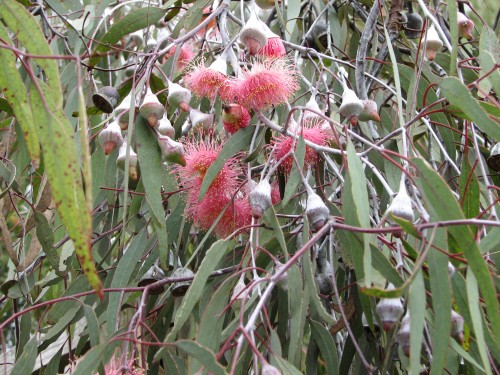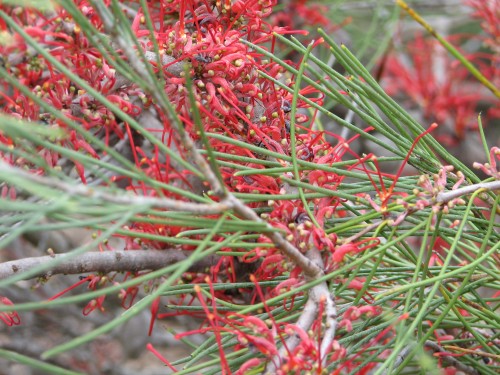Soils
I went looking for some garden loam today. I had this great idea that I would buy something with a lower pH than what is here, dig holes for the fruit trees which must be planted this week, and back fill with the better soil. Then I was going to put a 10cm layer, minimum, on the veggie beds, which will raise the beds and hopefully give some of the veggies a better start. Most like alkaline soil, but I think a pH of 9-10 is a bit much for any self respecting veggie.
Result? Soil with a pH of say 7.5 (I didn’t want much!) is like hen’s teeth around here. The landscape supply place had three lots for me to choose from, all them within the range of pH 8-9. One a loam, another, loam with chook manure added and much favoured for using to grow instant lawn, and a sandy loam mix. I went home feeling quite disheartened especially when the fellow said that they went looking for acid loam and found that it was loam with turkey manure in it to make it acid! What hope is there for we country folk!
End result is that I opted, after some thought, to get the loam thinking that at least is does not have limestone rubble in it. I will still need to work on it with manure and compost and probably sulphur. This could be an interesting experiment.
Planting in Dry and Alkaline Areas
I have been finding plants in the nursery that need to be planted out while the soil is still reasonably warm. There are quite a few, including some very neglected Eucalypts. Thought I would do a list in the blog of plants for our dry situation here. The average rainfall here is 330mm or 13 1/4 inches. Mostly winter falls, and often not heavy at any one time. When we get more than 20 points (5mm) in a day it is a time for rejoicing. We had 40 points last Thursday and the benefit can be seen immediately.
The soil here is mostly very alkaline. Some areas of the town and outlying districts go down to neutral. The soil structure is quite good apart from patches of ‘non wetting’ or water repellant sand. It is the limestone rubble that is the problem. At least the drainage is good. None of the books will say what plants will adapt to these highly alkaline soil conditions. In fact there are many plants which will grow happily in alkaline soil, even though the books do not say this. It is the highly alkaline soil which makes life a little more difficult. It has to be a trial and error situation. So my list will reflect what I know to be true.
It is worth getting the soil tested. A test kit costs something like $25 and will last for years. If there is an opportunity to have soil tested at a plant sale, take advantage of the offer. Sometimes plants which are acid soil lovers will grow in alkaline soil, even if not to the ultimate size that is listed. Others will look very yellow and deteriorate. There are remedies which will improve this, like iron chelates or sulphur watered in to the soil surrounding the plant. Follow the directions on the container.
In poorly drained soil it is worth raising the level of the soil by creating small catchment areas and adding the soil to one side in the form of a mound. Planting on the mound will make an amazing difference to some plants. I have heard that the raised area will also decrease the effects that high alkalinity has on some plants.
I will begin the list tomorrow.
How to plant Australian native plants
Early autumn is an excellent time for planting Australian native plants. The soil is still warm, the extremes of temperature have, in general, passed and rainfall becomes established again in the temperate areas of Australia.
Good gardening practice will always give good results for planting any types of plants, and Australian natives are no exception to this rule.
1. *Weed control is most important. Remove all weeds from the area to be planted. Be aware that cultivating the soil often will encourage weeds to establish. (On the other hand some native grasses will establish on uncultivated soil).
2. *Prepare the soil by forking to at least the depth of the root system, plus half again, and a diameter of 30-50cm (12-18inches) depending on the pot size.
3. Dig in whatever well rotted organic matter you may have, or keep it to apply to the soil surface.
4. I find it a useful thing to fill the planting hole with water and allow the water to drain away. This not only gives moisture in the subsoil to encourage roots downwards, but enables you to check the drainage of the area.
5. Create a raised planting site by bringing in soil from another area of the garden, if poor drainage is a problem or
6. Add gypsum to the soil if water seems to sit too long in the planting hole. About a kilo per square metre is recommended on poorly draining soils ie those that are mostly clay.
7. If water sits on the surface and seems to bead, non wetting soil is probably the problem. Buy a suitable soil re-wetting agent and follow the directions on the container. These are usually added after the planting is done. Similarly when watering fails to wet potting mix, dunk the container in a bucket or tub such as a garbage bin and if necessary add soil wetter to the water or the surface of the pot depending on the product being used.
8. *In general it is a good idea to soak potted plants in a bucket of water with some soil wetting agent added to it just before planting. (Unless you know for sure that the pot already contains this.) Soak long enough for bubbles to stop rising.
9. Adding fertilizer to the soil immediately below the plant can be a good thing. Use about a tablespoon of slow release fertilizer suitable for native plants, or use blood and bone added to the soil used to put around the plant in the planting hole.
10. *When placing the plant, create a small depression in the soil to act as a water catchment for rain or as a dam for hand watering.
11. *Plants need to be established by regular watering around the roots for several weeks, then weekly watering then leave greater intervals, depending on the amount of rainfall received. Don’t expect the plant to survive on natural rainfall if autumn rains have not begun in your district.
12. *Mulch the area surrounding the plant, keeping the mulch back a little from its stem.
13. *Use inorganic mulches like small sized gravel or sand that is free of weed seed.
14. *Or use organic mulches which will break down over time and need replenishing, but in doing so will add humus to the soil.
15. *Suitable organic mulches would be bark or wood chip, pea straw, rotted lawn clippings, or other rotted vegetable material or waste material.
The points marked * are the minimum that should be done.
Soils aint soils…
…to misquote an ad of some years ago! Where I live in the Mallee area of South Australia, the soil is very poor and the rainfall is low. So when it rained on the north coast of New South Wales last week, the amount of rainfall was incomprehensible. 14 inches (350mm) in a day at Bellingen, inland from Coffs Harbour! That’s more than we get in an average year.
I measured the pH of the soil at a number of locations over our 5 acres (2 hectares). Is it any wonder the fruit trees have not done as well as I had hoped. The pH is 8+ to 9+ which is highly alkaline. The quality of the soil varies from sandy loam, to limestone rubble to non-wetting mallee sand. There used to be a strawberry farm on our property, so the structure of the soil is not too bad at all.
My usual reaction to someone who says “that won’t grow on your block of land” is to attempt to prove them wrong. I don’t think I am alone! A lot of plants grow very well in alkaline soil. Some plant species will grow reasonably well, but do not achieve the ultimate size. Others sit and “sulk”, and others struggle to maintain good leaf coverage. Of course some of the most desirable plants (in my eyes) are the ones that are native to areas of acid soil! It is amazing how adaptable Australian native plants are.
When I began writing this piece I wondered if I really understood the science behind pH of soils, so I detoured to find some more info. I am glad I did. I realise that I should have been using iron chelate or iron sulphate more diligently on some plants and would have far better growth by now. Some homework to do later this week.
For more information on soil pH see the ASGAP web page Understanding Soils and Nutrients.

